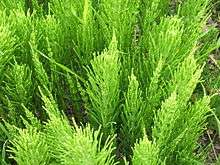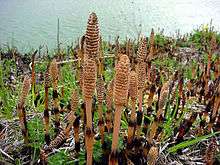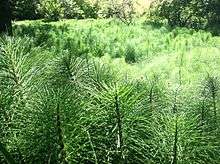Equisetum arvense
| Equisetum arvense | |
|---|---|
 | |
| Photosynthetic summer foliage | |
| Scientific classification | |
| Kingdom: | Plantae |
| Division: | Pteridophytes |
| Class: | Equisetopsida |
| Order: | Equisetales |
| Family: | Equisetaceae |
| Genus: | Equisetum |
| Species: | E. arvense |
| Binomial name | |
| Equisetum arvense L. | |
| Synonyms[1] | |
| |
Equisetum arvense, the field horsetail or common horsetail is a herbaceous perennial plant, native throughout the arctic and temperate regions of the northern hemisphere. It has separate sterile non-reproductive and fertile spore-bearing stems, growing from a perennial underground rhizomatous stem system. The fertile stems are produced in early spring and are non-photosynthetic, while the green sterile stems start to grow after the fertile stems have wilted, and persist through the summer until the first autumn frosts.[2][3] It is commonly confused with mare's tail, Hippuris vulgaris.[4]
Description
The sterile stems are 10–90 cm tall and 3–5 mm diameter, with jointed segments around 2–5 cm long with whorls of side shoots at the segment joints; the side shoots have a diameter of about 1 mm. Some stems can have as many as 20 segments. The fertile stems are succulent-textured, off-white, 10–25 cm tall and 3–5 mm diameter, with 4–8 whorls of brown scale leaves, and an apical brown spore cone 10–40 mm long and 4–9 mm broad.[2]
It has a very high diploid number of 216 (108 pairs of chromosomes).[2]
The specific name arvense is derived from the Latin arvensis, meaning "from the meadow, field or grassland."
Uses

The plant contains several substances which can be used medicinally. It is rich in the minerals silicon (10%), potassium, and calcium. The buds are eaten as a vegetable in Japan and Korea in spring time. All other Equisetum species are toxic.

In polluted conditions, it may synthesize nicotine.[5] Externally it was traditionally used for chilblains and wounds.[6] It was also once used to polish pewter and wood (gaining the name pewterwort) and to strengthen fingernails. It is also an abrasive. It was used by hurdy-gurdy players to dress the wheels of their instruments by removing resin build up.[7]
Equisetum is used in biodynamic farming (preparation BD 508) in particular to reduce the effects of excessive water around plants (such as fungal growth). The high silica content of the plant reduces the impact of moisture.[8]
E. arvense herb has been used in traditional Austrian medicine internally as tea, or externally as baths or compresses, for treatment of disorders of the skin, locomotor system, kidneys and urinary tract, rheumatism and gout.
Invasive species

Equisetum arvense was introduced into New Zealand in the 1920s and was first identified as an invasive species there by Ella Orr Campbell in 1949.[9] It is listed on the National Pest Plant Accord preventing its sale, spread and cultivation.[10]
References
- ↑ Tropicos
- 1 2 3 Hyde, H. A., Wade, A. E., & Harrison, S. G. (1978). Welsh Ferns. National Museum of Wales ISBN 0-7200-0210-9.
- ↑ Flora of North America: Equisetum arvense
- ↑ Dao-Lan, Xu; Jian-Guo, Cao; Quan-Xi, Wang; Xi-Ling, Dai (November 2015). "Cloning and Characterization of DEAD-box RNA Helicases Gene from the Fern Equisetum arvense". Plant Diversity And Resources. 36 (6): 715–722. doi:10.7677/ynzwyj201414036.
- ↑ Bebbington, A. "Toxicity of Equisetum to Horses". Retrieved 1 December 2010.
- ↑ Howard, Michael. Traditional Folk Remedies (Century, 1987); p.159-160
- ↑ La Vielleuse Habile, Jean-Francois Bouin, 1761, page 19.
- ↑ Kearny, Peter. "Bio Dynamic Prep 508". Bio Dynamic Prep 208. City Food Growers. Retrieved June 2011. Check date values in:
|access-date=(help) - ↑ Clemens, J (2003). "In Memory of Ella O. Campbell, DNZM, FRIH" (PDF). Royal New Zealand Institute of Horticulture. 6 (1): 2. Retrieved 14 March 2015.
- ↑ Howell, Clayson (May 2008). Consolidated list of environmental weeds in New Zealand (PDF). DRDS292. Wellington: Department of Conservation. ISBN 978-0-478-14413-0. Retrieved 2009-05-06.
External links
| Wikimedia Commons has media related to Equisetum arvense. |
- E. arvense at Germplasm Resources Information Network (GRIN)
- Une entreprise en procès pour avoir commercialisé de la prêle (French)
- Horsetail at Medline
- Field Horsetail at Biosecurity New Zealand
- Washington Native Plant Society